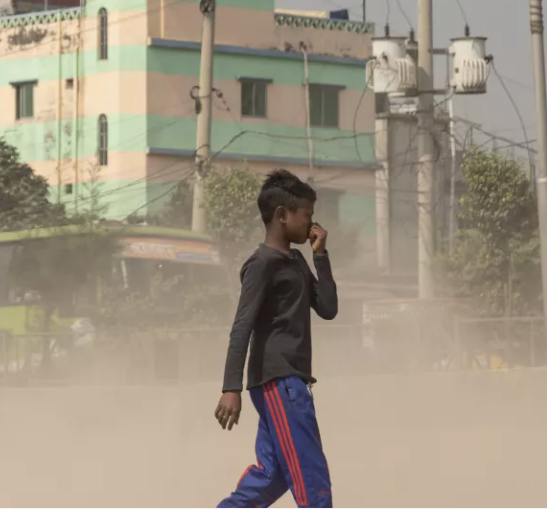Every child has the right to a safe, clean and healthy environment. It is critical for their growth and development. Breathing unhealthy air puts children and pregnant women at risk for adverse health effects and even death.
As our environment continues to change at alarming rates, we look at what air pollution is, how children are impacted and what steps are needed to protect them.
8.1 trillion
US dollar has been spent to address air pollution as a multifaceted problem globally in 2019.
26 per cent
of all child deaths every year are due to avoidable environmental risks.


Air pollution: Fast facts
Air pollution is a complex mix of pollutants including fine particles and harmful gases like nitrogen dioxide, sulfur dioxide and carbon monoxide. These can penetrate deep into our lungs and bloodstream and cause lasting damage to our health.
Polluted air can be found in indoor and outdoor settings and can move rapidly between the two. It can travel hundreds or thousands of kilometers from its source.
- Outdoor or ambient
Most air pollution comes from industrial sources like power plants and factories that burn fossil fuels (coal, oil, natural gas); road traffic; waste management; excessive fertilizer and pesticide use and burning of agricultural waste; and wildfires. - Indoor or household
Household pollution is a prominent contributor of poor air quality and is responsible for almost half of the air pollution deaths globally. Poor ventilation combined with indoor smoke from coal and wood burning stoves can release levels of fine particles 100 times higher than the acceptable rate.
Air pollution can cause serious environmental and health hazards, including fatal diseases in people and animals. Difficulty breathing is linked with respiratory diseases like asthma and bronchitis.
Air pollution can also have long-term health impacts, including cardiovascular diseases, lung cancer and diabetes.
Children exposed to air pollution tend to have respiratory problems later in life.
Climate change and air pollution impact each other. When the temperature is high, the level of air pollutants goes up. Heatwaves and other climate-related events such as wildfires worsen air quality. In turn, air pollutants such as carbon dioxide are also major greenhouse gases that can accelerate climate change.
Nearly half the world’s children live in countries that are at extremely high-risk from climate change effects. As the climate changes, air pollution will become an increasing threat to children.
Children and air pollution
Children’s lungs are in the process of growing and developing, making them especially susceptible to polluted air.
Children breathe twice as quickly as adults and take in more air relative to their body weight. Many young children often breathe through their mouth, which takes in more pollutants. They are also closer to the ground, where some pollutants reach peak concentrations.
Children’s immune systems are weaker than that of adults and their respiratory tracts are more permeable. They’re also at greater risk of viruses, bacteria and other infections during early childhood.
Children who breathe polluted air are at higher risk of acute respiratory infections like pneumonia. Those that live in polluted environments can have their lung capacity reduced by 20 per cent. That’s similar to the effect of growing up in a home with secondhand cigarette smoke.
Air pollution is associated with pneumonia, which is the largest infectious cause of death in children globally.
The first 1,000 days of a baby’s life are a critical period of vulnerability from air pollution. Exposure during this period can alter their physical and cognitive development, which can lead to childhood and adult disorders.
Air pollution can also negatively impact the duration of pregnancy and weight of the newborn child. It accounts for 20 per cent of newborn deaths worldwide, most related to complications of low birth weight and preterm birth.
Air pollution disproportionately harms children living in poverty, accounting for most illnesses and premature deaths in low- and middle-income countries.
Poverty forces people to use polluting fuels and devices for cooking, which is a major source of indoor air pollution.
Many of the worst sources of outdoor air pollution, like power plants, factories and busy roads, are often located in poorer communities. Air pollution also impacts low-quality housing, as well as informal or temporary settlements such as refugee camps.
1.8 billion
– or around 93 per cent of children under the age of 15– breathe air that is so polluted, it risks their health and development.